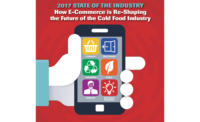Ever since consumers discovered they could leverage technology to understand, question or otherwise engage with the products they buy, the retail grocery industry has never been the same. In the 10 years since the advent of the smartphone, consumers have been in the driver’s seat, becoming better informed about ingredients, allergens and other dietary considerations. That’s why consumers are forcing the reorientation of supply chain processes and driving forward significant change in the industry.
Looking ahead to 2017, the retail grocery industry—retailers, suppliers, manufacturers, distributors and solution partners—will keep a continued focus on the consumer and how they interact with technology to enhance sales, speed efficiencies and innovate for long-term success. Here are four topics certain to be on any industry leader’s “to-do” list for 2017.
Transparency
Consumers demand ingredients, allergens and other information about products prior to purchase, however the current state of data is often disorganized and incomplete upon retrieval from web searches and apps.
That’s why GS1 Standards powers automatic data capture, so that companies can share information about a product as it moves through the supply chain. For example, applying a barcode that contains a Global Trade Item Number (GTIN) brings more efficiency and consistent information and allows companies to tie specific attributes to a product. With the exchange of standardized product information, it becomes possible to move away from proprietary, manual and paper-based systems. Business transactions become more seamless, especially with the ability to link internal systems to an external one all trading partners can utilize. GS1 Standards provide this critical bridge for enhanced collaboration on product transparency.
To enable better transparency, interactive physical packaging also is being explored as a portal to push dynamic and useful content to consumers. GS1 US Mobile Scan enables brands and retailers to deliver robust product information such as coupons, instructional videos and more to consumers via nearly invisible barcodes that can be scanned by a smartphone.
Traceability
In 2017, it truly becomes imperative that all members of the food supply chain evaluate how effective their traceability programs would be if faced with a major recall.
The GS1 Standards, created to support supply chain visibility, such as the GS1-128 barcode for case level labeling, as well as the guidelines developed for industry implementation, continue to meet the needs of the industry. But, it can’t be done in a vacuum—an effective traceability program requires all supply chain partners to leverage global standards, which enables the end-to-end supply chain visibility needed to pinpoint affected product identified during outbreaks. Look for more industry collaboration to speed effective traceability programs that protect consumers and brand reputations.
E-commerce
Many are finding the same system of GS1 Standards that was implemented in the grocery industry more than 40 years ago for speedy and efficient checkout purposes provides the inventory visibility and supply chain efficiency needed to meet today's omni-channel needs across all retail categories. By leveraging standards to their fullest potential, retailers and brands can collaborate to forecast trends more accurately and improve digital shelf availability.
Digital coupons
The world has become more paperless, and mobile device platforms have enabled an easier digital payment experience. GS1 US, Lawrenceville, N.J., and the grocery industry, via the Joint Industry Coupon Committee (JICC), collaborated to differentiate paper from paperless coupon redemption standards for transaction auditability.
Now that the standard has been created, in 2017, the industry will begin to fully leverage its benefits and further bridge the gap between the digital and physical worlds to help support the full omni-channel experience.
The year ahead will ultimately be focused on more action being taken to not just effectively meet consumer expectations, but also create “wow” experiences that exceed expectations.




